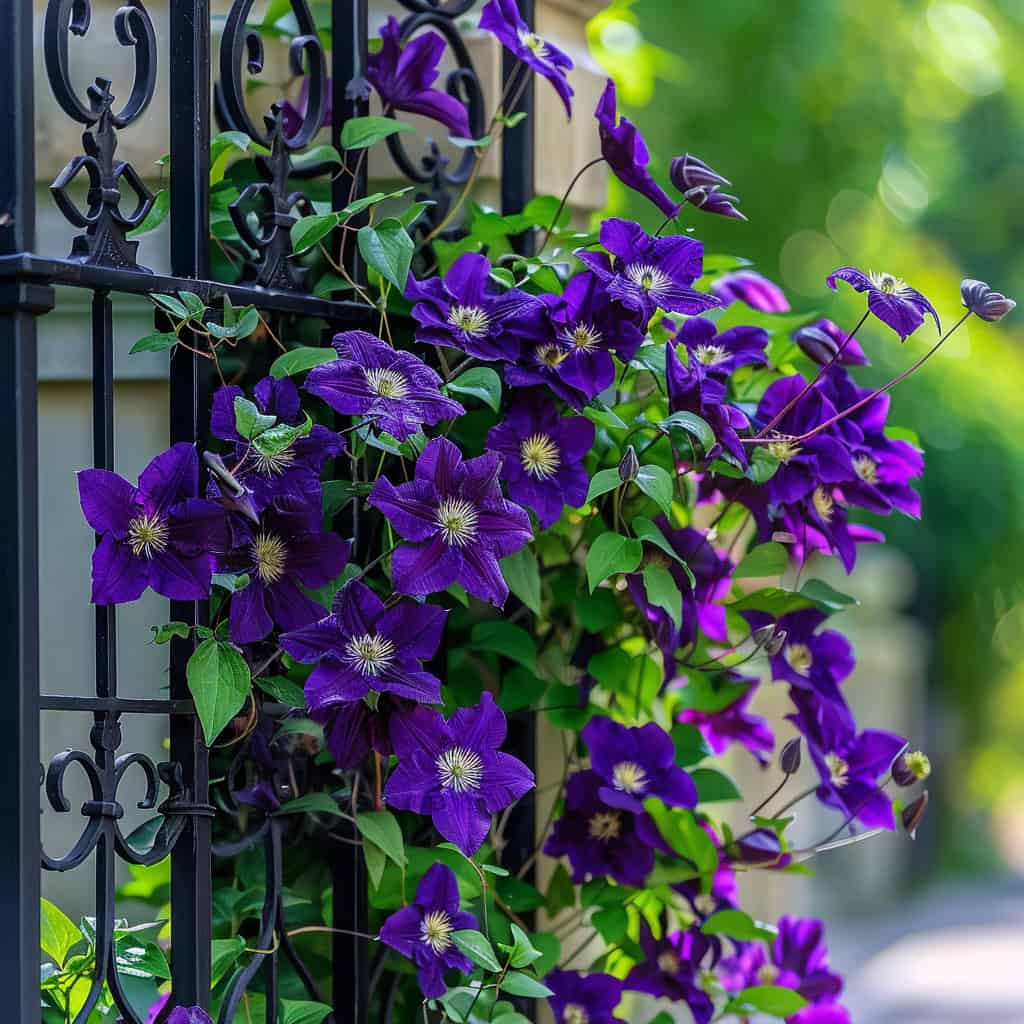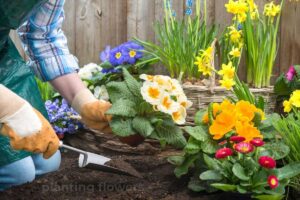This page may contain affiliate links. If you click and buy, we might get a small commission at no cost to you.
Clematis is a beautiful and versatile flowering vine that can add a touch of elegance to any garden. Known for its large, vibrant blooms, this plant is a favorite among gardeners and landscape designers alike. Clematis is native to regions of Europe, Asia, and North America, thriving in temperate climates. In the United States, several species such as Clematis virginiana grow wild in woodlands, along riverbanks, and in open fields.
The flowers come in a stunning array of colors, including shades of purple, blue, pink, red, and white. Clematis blooms also vary in form, with some being single, double, or bell-shaped. This variety allows gardeners to choose the perfect clematis to complement their garden design and personal taste.
Beyond their aesthetic appeal, clematis vines are relatively easy to grow and care for with the right knowledge and preparation. Here are some essential tips to help you grow a happy clematis vine with big blooms.
10 Steps to Grow a Happy Clematis Vine with Big Blooms
1. Choosing the Right Variety
Selecting the right clematis variety is crucial for success. Consider your climate and garden conditions. Some varieties, such as ‘Nelly Moser’, are more tolerant of shade, making them ideal for less sunny spots.
In contrast, ‘Jackmanii’ and ‘President’ thrive in full sun. Researching and selecting the right variety for your specific environment will set the foundation for a healthy, blooming plant.
2. Selecting the Ideal Planting Site
Clematis vines need at least six hours of sunlight per day to flourish. Choose a location where the plant can receive ample sunlight while ensuring that the base of the plant and roots are kept cool.
This can be achieved by planting other low-growing plants around the base or using a layer of mulch. The roots need to stay cool and shaded to prevent them from drying out and overheating.
If planting in a pot, select a large container with good drainage and place it in a spot that gets plenty of sunlight. Ensure the pot is shaded at the base to keep the roots cool.
3. Preparing the Soil
Clematis thrives in well-drained, fertile soil. Before planting, amend the soil with compost or well-rotted manure to improve its texture and nutrient content.
The soil should be slightly alkaline to neutral, so consider adding lime if your soil is acidic. Digging a hole about twice the size of the root ball and mixing in organic matter will give your clematis a good start.
4. Planting Your Clematis
Plant clematis in the spring or early fall. Dig a hole twice the size of the root ball and place the plant in the hole with the crown about 2-3 inches below the soil surface. This planting depth helps protect the plant from clematis wilt.
Fill in with soil, firming it gently around the roots, and water thoroughly. Ensuring the soil is well-prepared and the plant is correctly positioned will encourage robust growth and blooming.

5. Watering and Mulching
Consistent moisture is key to growing healthy clematis vines. Keep the soil evenly moist but not waterlogged. During dry spells, ensure that the plant is adequately watered.
Applying a layer of mulch around the base of the plant will help retain moisture, regulate soil temperature, and prevent weeds. Mulch also helps keep the roots cool, which is vital for the health of the plant.
6. Providing Proper Support
Clematis vines need a support structure to climb, such as a trellis, arbor, or fence. Install the support before planting to avoid damaging the roots later.
As the vine grows, gently train it onto the support, tying it loosely with garden twine if necessary. Proper support allows the plant to climb and display its beautiful blooms prominently.
7. Pruning for Health and Blooms
Pruning clematis correctly is essential for maintaining plant health and encouraging abundant blooms. Clematis are divided into three pruning groups. Group 1 includes early-flowering clematis that should be pruned right after flowering.
Group 2 includes large-flowered hybrids that need light pruning in early spring. Group 3 includes late-flowering clematis that should be pruned back hard in early spring. Knowing your clematis type and pruning accordingly will result in a healthier plant with more flowers.
8. Fertilizing Your Clematis
Feed your clematis with a balanced fertilizer in early spring and again in mid-summer. A slow-release fertilizer or well-balanced organic fertilizer works well.
Be careful not to over-fertilize, as this can lead to lush foliage at the expense of flowers. Regular feeding ensures that your clematis has the nutrients it needs to produce vibrant blooms.
9. Pest and Disease Management
Clematis can be susceptible to pests like aphids and slugs, as well as diseases such as clematis wilt and powdery mildew. Regularly inspect your plants and treat any infestations promptly.
Organic insecticidal soap can help manage pests, while good air circulation and proper spacing can prevent fungal diseases. Keeping your clematis healthy through proper care and vigilance will minimize pest and disease issues.
10. Winter Care and Protection
In colder climates, clematis requires some winter protection. Apply a thick layer of mulch around the base of the plant to insulate the roots. In areas with severe winters, consider covering the lower part of the vine with burlap or similar material to protect it from freezing temperatures. Proper winter care ensures that your clematis survives the cold months and returns strong in the spring.
By following these detailed steps, you can grow a healthy clematis vine that will reward you with stunning blooms year after year. Enjoy the beauty and elegance that clematis brings to your garden!
Frequently Asked Questions About Clematis
Q: When is the best time to plant clematis?
A: The best time to plant clematis is in the spring or early fall when the weather is mild.
Q: How much sunlight does clematis need?
A: Clematis needs at least six hours of sunlight per day to thrive and bloom well.
Q: Can clematis be grown in pots?
A: Yes, clematis can be grown in large pots with good drainage and should be placed in a sunny spot.
Q: How often should I water my clematis?
A: Water clematis regularly to keep the soil consistently moist, especially during dry spells.
Q: What type of soil is best for clematis?
A: Clematis thrives in well-drained, fertile soil, ideally amended with compost or organic matter.
Q: Do clematis vines need support?
A: Yes, clematis vines need a support structure like a trellis, arbor, or fence to climb.
Q: How should I prune my clematis?
A: Prune clematis according to its pruning group (1, 2, or 3) to maintain health and encourage blooms.
Q: What should I do if my clematis gets clematis wilt?
A: Remove and destroy the affected parts of the plant immediately to prevent the spread of the disease.
Q: How can I keep the roots of my clematis cool?
A: Mulch around the base or plant low-growing ground covers to shade and cool the roots.
Q: Is clematis susceptible to pests and diseases?
A: Yes, clematis can be affected by pests like aphids and slugs, as well as diseases like clematis wilt and powdery mildew. Regular inspection and proper care can help manage these issues.



